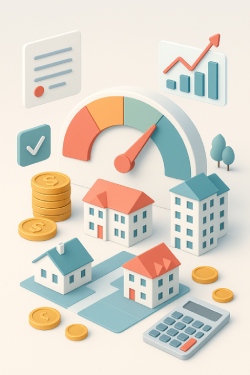The Top Steps to Owning Your First Home in Canada
Understandably, many aspiring first-time homeowners are often at a loss as to where to start when navigating the Canadian real estate. Should they start with saving for a home? How about finding an agent to lead the way? With these and many other questions swirling in your mind, we know just how confusing home buying can be, and that is why we have created a step-by-step guide which explains everything you need to do.
Step 1: Do In-Depth Property Research
If you ask some people what you need to do when buying a home, they will tell you that you need to save money. And while this is true, as we will cover in a later section, you must also understand what you are saving for. Think about it like buying a car or taking on a course. Don’t you first decide on the car model before putting money aside to cover the purchase? Wouldn’t you also research how much a course costs before embarking on savings? This prior knowledge helps you understand exactly what you need to make the purchase, which makes it easier for you to gauge the gap between what you have and what you should have.
The same goes for homes. Canada is rich with homes that differ from each other in the following ways:

Property Types
Would you prefer to live in a detached house or would you love to buy a townhouse? How about a condominium? These are all examples of properties that you will come across. But when choosing homes, your focus should not just be on their facades. You should also consider the appreciation trend of the property type as well as its maintenance needs. Take condos as an example. These have lower maintenance needs, but they come with specific rules and fees that apply to all condo owners. And if you opt for a detached house, you can avoid these fees and rules, but you would also need to put away some money to account for its high maintenance needs. So, as you consider which home is best for you, think about the homeownership costs well into the future.
Locations
What matters to you when it comes to location? Is it nearness to schools? How about transit access? Your choice of neighborhood will ultimately affect the quality of your life. But that’s not all. It will also play a key part in your home’s resale value should you ever wish to sell it on the open market. So, how can you ensure that you make the right choice? Start by making a list of your non-negotiables, such as school quality and commute time. Then, make another list with the things that would be nice to have, such as nearness to shopping centers and parks. These are the features you will use when selecting the locations that you will consider.
Finally, based on your preferred property types and locations, do a general search of how much homes that meet these criteria cost. If the costs are beyond what you can afford, you may need to prioritize your non-negotiables while compromising on the location features that would be nice to have. Once you have achieved a good balance, you will now have a clear idea of the general cost of your future home, which will inform the next steps.
Step 2: Start Saving for Your Home
Now that you have a good idea of how much your house will cost, it is time to come up with a savings strategy. At this point, you may wonder just why you can’t fund your entire home with a loan. Well, here are some good reasons.

Eligibility
Many mortgage companies and banks will not even consider your home-financing application if you do not have savings to finance the down payment. Of course, the percentage required varies, but you must have something to show that you will put down a substantial amount to finance the home. Usually, you must put down 5% for the first $500,000, then 10% of the amount between $500,000 and $999,999, and 20% for homes valued at $1 million or more.
Monthly Payments
The larger your down payment, the lower the loan amount, and the less money you will owe in mortgage payments. So, if you can avoid taking on a huge loan, you can reduce your repayment period or stretch it to pay less in the monthly payments. Without a good down payment, such flexibility is hard to negotiate with your financier.
Insurance
For most mortgage applications, you need to put down at least 20% of the home price, else you must take on a mortgage loan insurance. Unfortunately, this additional insurance comes at an extra cost, thus raising the cost of the home’s purchase price.
So, how can you save enough money to cover your first home? First, come up with a savings goal based on the down payment of your preferred property type and location. As you do this, please note you should also keep the closing costs in mind, which often amount to 1% to 4% of the home price. Secondly, we recommend signing up for savings accounts, including those offered by the government, such as the Home Buyers’ Plan, as these help you build your savings account while offering tax advantages. It’s also best to automate your savings contributions so that these take place like clockwork, so that you never have to think about making these deductions.
Step 3: Build Your Credit
Your home financier will not just look at your savings. They will also want to check your credit health. Why? Well, this score measures your debt-to-income ratio, and it enables them to gauge the following:

Your Borrowing Capacity
A mortgage company or bank will never give you more money than you can afford to pay back. Keep this in mind when choosing properties, as they must be reasonably priced in relation to your income.
Your Qualification
Not all mortgage applications go through. In some cases, banks and mortgage companies will reject an application because the applicant falls short in terms of the income or debt requirements. For example, if you have a history of bad debt or currently have a high debt-to-income ratio, you will likely face rejection.
Your Interest Rate
Did you know that mortgage interest rates are also based on risk? The greater the risk that the bank or mortgage company takes in offering you a loan, the higher your interest rate will be.
Given that your financial health plays such a crucial role in whether you even get a loan, we advise you to start by calculating your debt ratio. If using the gross debt service ratio, your monthly housing costs should not exceed more than 39% of your gross income. And if you are using the total debt service ratio, then your monthly housing costs and any other debt payments should not be more than 44% of your gross income. Besides debt ratios, you should pay attention to your credit report, as this helps you take note of your debts so that you can improve your debt scores. There are many ways to keep your debt low, including paying your bills on time, reducing your credit card balances, and even closing some of your credit accounts. The better your ratios at the time of the application, the greater the likelihood of getting a green light from your financier.
Step 4: Get the Mortgage Pre-Approval
The time taken to apply for a mortgage pre-approval differs from person to person as it comes down to how long it takes for you to build a good credit score and save enough for a sizeable down payment. So, what exactly is a pre-approval? Well, it’s the go-ahead that your mortgage financier gives you, indicating that they are willing to fund your home-buying process, and it comes with the following advantages:
Spending Cap
Once your financier assesses your debt ratios and savings, they are able to determine just how much they can offer you. This way, you know exactly how much you can spend on the house, which helps you narrow down your search to properties within this budget that meet your earlier selected criteria.
Rate Hold
A pre-approval comes complete with an interest rate, which the financier puts on hold for anything from 90 to 120 days. Thanks to this hold, you can go house-hunting with the assurance that even if the market interest rates go up, your offer will remain unchanged.
Confidence
When home sellers see that you already have a pre-approval, they take you more seriously as a buyer, as they know that you have the financing already taken care of. This qualification even opens you up to off-market properties where sellers may only want to deal with buyers who they deem as serious.
Okay, so how do you get this pre-approval? Your financier determines what is necessary. However, in most cases, you will need to present proof of income and proof of down payment savings to the financier, who will then assess your financial health and determine if they can offer you a mortgage and at what rate. If you pass the checks, you get a pre-approval letter with all the terms and conditions of your loan. To get the best rate, we recommend that you work with a licensed mortgage broker, as they can get you rates from different lenders, enabling you to choose the most favorable option.
Step 5: Find a Realtor
Yes, we saved the best for last. Now that you know what kind of property you want and have the financing to back it, you can confidently engage a realtor who works in your preferred location, who can help you find properties that match your needs, including those that may not be on listing sites. The good thing is that in most Canadian provinces, sellers pay the agent’s commission, so this will likely come at no cost to you. But even if it does, having a realtor by your side is important. Not only do they draft the offers, but they also advise you on home inspections and closing tips. Most importantly, they step in during the final price negotiations, which works to your advantage as they are well-versed in these matters. To ensure the collaboration is successful, ensure your realtor understands your budget and non-negotiables.
Once you have found the perfect fit, you can then proceed with the inspections and closing.
